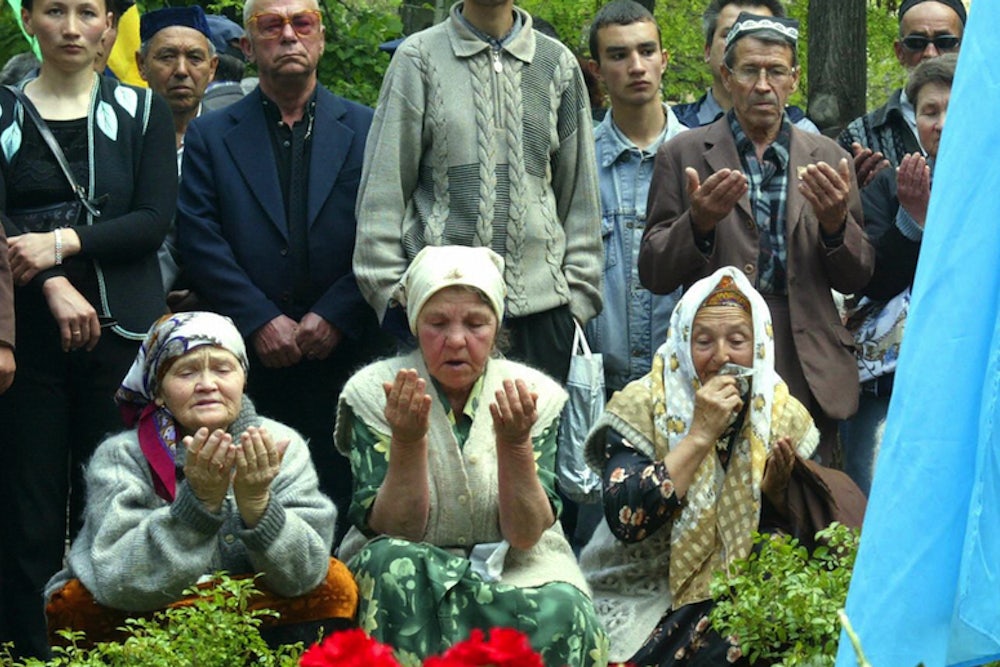As of this morning Russian forces control the Crimean peninsula, home to some 2 million people, the vast majority of whom are ethnically Russian. On the phone with President Obama yesterday, Putin justified the seizure of the area by claiming that Russia has the right to defend the well-being of its “citizens and numerous compatriots,” and the Russian-speaking population of Ukraine. One of the doctrines of Russian foreign policy, as my colleague Julia Ioffe explained, is that “Russian ethnicity and citizenship trump national sovereignty.” In Crimea, that has historically meant that Russia will deport and erase any claim that the peninsula’s oldest community—the Tatars—may have on the land in order to secure complete control. Finding themselves once again under Russian control is a nightmare scenario for the Tatars, the biggest victims of Russia’s new Crimean war.
The Tatars have been in Crimea since at least the late 14th century. They came to the area as part of Genghis Khan’s army and stayed there after the Mongol Empire split up into the four khanates of Kazan, Astrakhan, Sibir, and Crimea. Russia quickly swept up all but Crimea, which became part of the Ottoman Empire. In 1783, the Ottomans handed it over to Catherine the Great, and Crimea remained part of Russia for almost two centuries—as far as Russians are concerned, Crimea was, is, and will be a part of their country.
Under Tsarist rule, anti-Tatar policies were enforced and thousands of Russian speakers settled the peninsula, displacing the Muslim Tatar minority. Things got better—briefly—after the formation of the Soviet Union, when the Crimean Autonomous Soviet Socialist Republic was created and the Tatars benefited from Bolshevik policies supporting Russia’s many ethnic minorities (two-thirds of the Bolshevik leadership was not ethnically Russian). They were represented in the Soviet government, and both Crimean Tatar and Russian were recognized as official languages in the region. There was even what scholars have called a Tatar “cultural revival” in Crimea up until 1928, when Stalin implemented his catastrophic Five-Year Plan.
Then agricultural collectivisation and sweeping purges of the Soviet population began; famine killed millions in Ukraine and, as Andrew Wilson of the European Council on Foreign Relations has pointed out, Crimea and Russification programs meant that Crimean Tatar had to be written in cyrillic instead of the Latin alphabet. Tatar historian Alan Fisher has said that between 1917 and 1933, 150,000 Tatars—about 50% of the population at the time—either were killed or forced out of Crimea.
Then in 1944, Stalin accused the entire population of Crimean Tatars of collaborating with the Nazis and deported them to Siberia en masse. Piled body to body in cattle cars--“crematoria on wheels,” half of the Tatar population died on the way. The Tatar population of Crimea fell to zero, all Tatar mosques were destroyed, and Stalin achieved his goal of expanding the Russian population further south.
Crimea remained part of Russia until 1954. That’s when, in what was supposed to be an empty gesture, Nikita Krushchev transferred Crimea to the Ukrainian Soviet Socialist Republic to commemorate the 300th anniversary of the Treaty of Pereyaslav, which established “eternal friendship” between Ukraine and Russia by subordinating the former to the latter back in 1654. It made for a complicated situation after the Soviet Union fell, as Crimea remained Ukrainian territory despite having a majority Russian population. In the early ’90s, all of the Tatars who Stalin exiled came flocking back to their homeland, and the Tatar population jumped from around 38,000 in 1989 to about 270,000 today.
Under Ukrainian rule, the Crimean Tatars have been able to exist more or less autonomously, though there have been constant tensions with the resident Russian population. In 1991, the Crimean region voted to restore the Crimean Autonomous Republic--enabling the Crimean ethnic Russian population to distance themselves from the Ukrainian government. As Tatar leader Mustafa Dzhemilev explained to RIA Novosti a few years ago, “Only Crimean Tatars were opposed, but most of them were still living in Central Asia, where Stalin had deported them in 1944.” Still, under the Autonomous Republic of Crimea, the Tatars have been represented in Ukrainian parliament and have been able to repopulate the peninsula—the current population stands at about 240,000. They mostly live in rural areas, and have been frustrated by the Ukrainian parliament’s repeated failures to enhance their status, Wilson has noted. But As Oxana Shevel wrote in the Washington Post, “Whatever the Tatar grievances against the Ukrainian state may be, when faced with the choice of being under either Russian or Ukrainian control, the Crimean Tatar leadership has consistently and unequivocally chosen Ukraine.” Dzhemilev told Shevel that in 1991, and again over the past weeks, Russia has reached out to the Tatars offering to give them “the status of Crimean Tatar national autonomy” in return for acceding to Russian control. Back in 2004, Dzhemilev warned that “Russia is seeking to use the Tatar issue to destabilize Crimea, and that Ukrainian authorities aren't helping the matter by reneging on promises to assist the Tatars.” Again, as far as Russians are concerned, Crimea was, is, and will be a part of their country.
The Tatars, given their history, won’t have it (though there are a small number of Tatars who do want to go back to Russian rule). But now it looks like they don’t have a choice. When Russian forces took over the Crimean parliament building on February 26, Dzhemilev was part of the Tatar delegation that was larger than the pro-Russian crowd of demonstrators. As Shevel noted, the Tatars are ready to join with Ukrainian forces to take up arms against the Russians. As one Crimean Tatar told the New York Times, “It is better to die here than leave again.”
